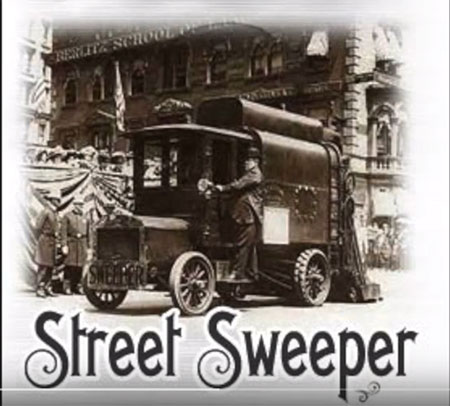The History of the Sweeping Industry |
Charles B. Brooks Patented One of the First Self-Propelled Street Sweepers
A Black man from Newark, New Jersey, Charles B. Brooks, invented the U.S.' first self-propelled street sweeper truck and patented it on March 17, 1896.If you could imagine the days where a man would manually have to sweep the streets with a long horizontal head broom, shovel and dustpan, one would quickly surmise that this invention was not only a time saver but also extremely economical. Historically, prior to Brooks' truck, streets were commonly cleaned by walking workers, picking up by hand or broom, or by horse-drawn machines. Brooks' truck had brushes attached to the front fender that pushed trash to the curb. There was less manual labor, less down time as we know what sweeping can do to one's back. Well, a man by the name It was a towed attachment with a built-in rotating brush wheel. Charles Brooks actually decided to improve on the sweeper design of C.S. Bishop, from Pennsylvania, who is credited with having invented the first street sweeper on September 4, 1849. Because Bishop's sweeper was a tow-behind machine, Brooks decided he could make the job a lot easier. As far as Brooks was concerned, the regular way of cleaning the streets was too daunting and not very cost-effective. So, he decided to create a sort of broom – or sweeper – and attach this device to a truck. Hence the concept was born of the 'street sweeper truck.' This was the first time a machine was built that looked more like what is used today. Brooks patent was approved on March 17th, 1896; his application for the patent was filed on April 20, 1895. The street sweeper could best be described as a truck frame mounted on the axles which are supported by front and rear wheels. There are drive-wheels for the sweeping, elevator mechanisms, and an endless chain that travels around a sprocket-wheel and travels up to an additional sprocket-wheel. There is a squared shaft, which is mounted at opposite ends in bearings in the upper parts of a pair of vertical standards consisting of the back or rear parts of the truck-frame and then sustained by braces, which extend from the standards to the truck-frame. The patent drawings go on to explain the complete composition of the invention. For those who are lost on the technical terms, above, here it is in layman terms: The truck had brushes attached to the front fender which would revolve. These revolving brushes could interchange to a flat scraper that could be used in the winter months for snow and ice. Below you will find Charles Brooks' patent drawings for the first self-propelled sweeper. However, if you want to view drawings of the first tow-behind sweeper, which was patented 47 years earlier by C.S. Bishop, use this link.
Brooks also patented the first paper punch with a receptacle for holding the 'chad pieces' – long before they were called that! If you know of a website where we can find a better picture of Charles Brooks, please let us know. Click on the following to view a brief YouTube video on Charles Brooks and his invention. (Will open in YouTube in a new browser window.) 
We're always on the lookout for more sweeper-oriented information we can add to the website, so keep us in mind if you find interesting information about sweeping. |
© 2005 - 2021 World Sweeper
|
Back to History of the Sweeping IndustrySite Map / Table of Contents |